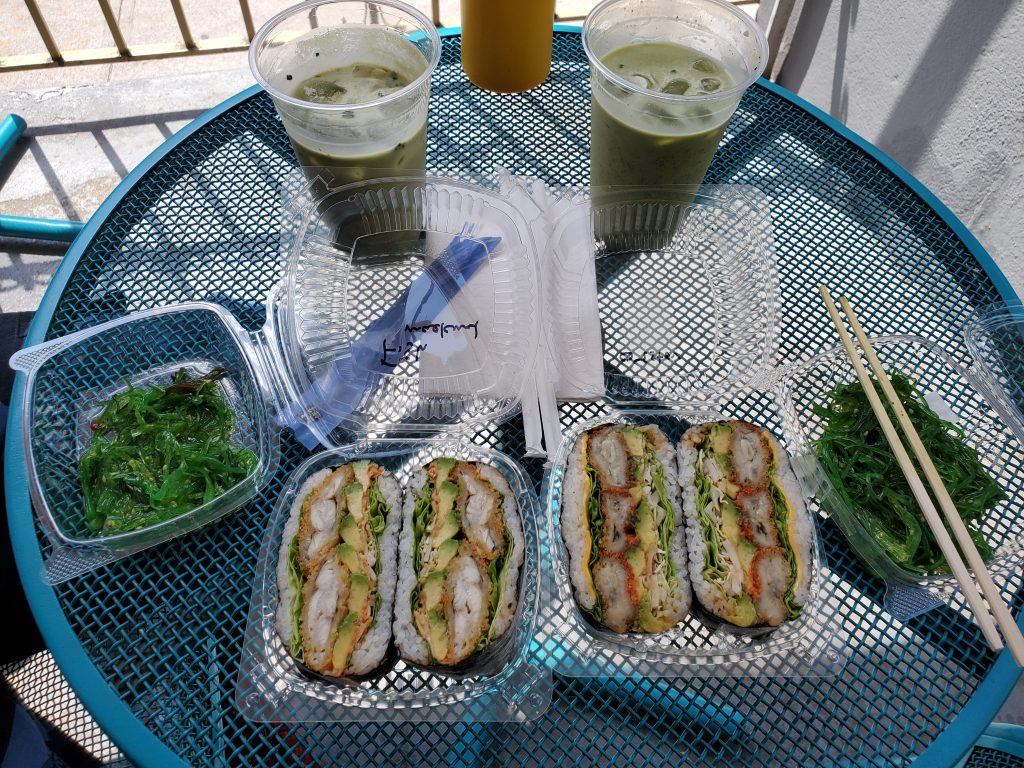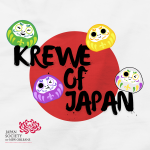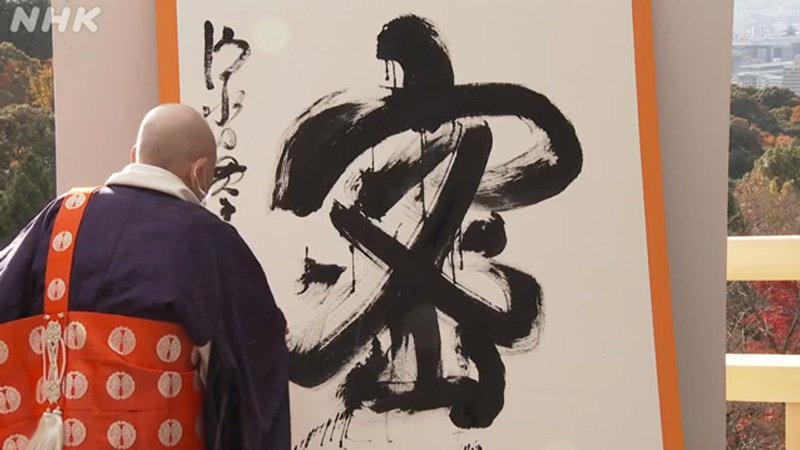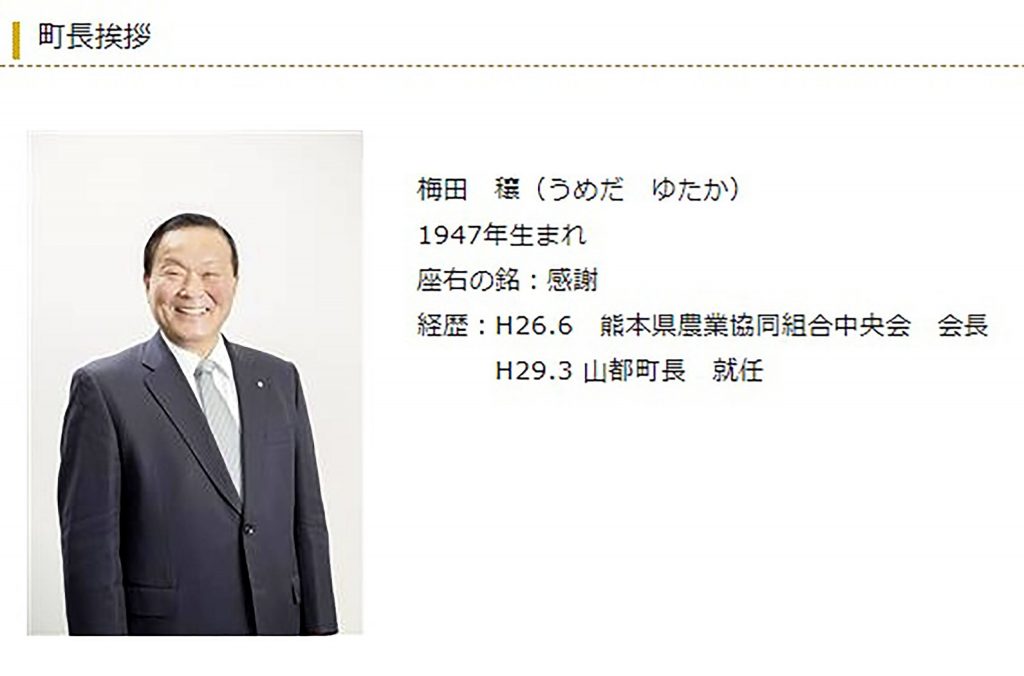WIT Life #358: LA eats Japan
Interpreter/Translator/Writer Stacy Smith (Kumamoto-ken CIR, 2000-03) presents WIT Life, a periodic series about aspects of Japanese culture such as art, film, food and language. Stacy starts her day by watching Fujisankei’s newscast in Japanese, and here she offers some interesting tidbits and trends along with her own observations.
Although the days are still balmy here in NY, we’ve had some chilly nights and mornings as we get deeper into fall. In LA however, the warm weather sticks around longer, allowing for fun outdoor activities as we move closer to winter. I’d like to share one that I wish I was able to attend in person!
LA eats Japan has been an annual food festival since 1999, and it will be held outdoors for the first time this year at Little Tokyo. This free event will be held on Sunday, November 14 from 11 am-8 pm, and is presented by the Japanese Restaurant Association of America with support from the Consulate General of Japan in LA.

There will be 17 vendors from local restaurants selling curry rice, yakitori, okonomiyaki, ramen, yakisoba and sushi, as well as sweets such as kakigori and castella. In addition to all this amazing food, there will be a cosplay costume competition with a prize of $1,000. Live performances will feature contemporary techno music, as well as traditional martial arts and music like karate and taiko. A mikoshi portable shrine will even be paraded through the streets!
For those who want to experience Japanese food, culture and sightseeing spots but aren’t able to travel at this time, I would like to recommend the Kyushu Virtual Fest to be held Thursday night. It is the second half of a two-part event, and I attended the first last night. Having lived in Kumamoto on JET, I was thrilled that they spotlighted Aso and other amazing places in the prefecture, as well as a waterfall I had never visited but hope to on my next trip. They also highlighted sites and products from Fukuoka and Kagoshima, and there were many giveaways and discounts for viewers. This event is free as well so definitely check it out!
WIT Life #357: LDP Presidential election and royal family shakeup
Interpreter/Translator/Writer Stacy Smith (Kumamoto-ken CIR, 2000-03) presents WIT Life, a periodic series about aspects of Japanese culture such as art, film, food and language. Stacy starts her day by watching Fujisankei’s newscast in Japanese, and here she offers some interesting tidbits and trends along with her own observations.
The Japanese LDP Presidential election will take place today (September 29th). The winner is expected to become the next prime minister following current PM Yoshihide Suga, leading the party in November’s general election. Here’s a run-down of the candidates, notable for being a lineup that is 50% women.

In other big news, Princess Mako of the royal family just welcomed home her fiancee, commoner Kei Komuro. When he was last in Japan over three years ago, he got engaged to Mako before coming to New York to attend Fordham Law School. They plan to marry and for Mako to return with him to New York, where he has been hired by a law firm. In renouncing her official title, she will be sacrificing almost $1.35 million in taxpayer money. Check out the Washington Post’s coverage of the palace intrigue captivating Japan (and the vitriol towards Komuro’s Covid ponytail)!
WIT Life #356: Tokyo 2020 Paralympic Games
Interpreter/Translator/Writer Stacy Smith (Kumamoto-ken CIR, 2000-03) presents WIT Life, a periodic series about aspects of Japanese culture such as art, film, food and language. Stacy starts her day by watching Fujisankei’s newscast in Japanese, and here she offers some interesting tidbits and trends along with her own observations.
Thanks to all the recent rain it seems as if the summer heat has broken a bit, but I can’t wait for fall to arrive, along with its cooler temps and 紅葉 (kouyou, or leaves changing color). Though I must say I’m not quite ready for the ubiquitous pumpkin spice marketing that has already started!

The Tokyo 2020 Paralympic Games began on August 24, and they feature over 4000 athletes from 162 National Paralympic Committees worldwide. You can find a recap of the Opening Ceremony here, and daily schedules/results here. The Games will run through September 5, so happy viewing!
WIT Life #355: Tokyo 2020 Olympics
Interpreter/Translator/Writer Stacy Smith (Kumamoto-ken CIR, 2000-03) presents WIT Life, a periodic series about aspects of Japanese culture such as art, film, food and language. Stacy starts her day by watching Fujisankei’s newscast in Japanese, and here she offers some interesting tidbits and trends along with her own observations.
A quick mid-summer hello to all and hope those Olympic fans out there are enjoying the games. In lieu of a longer post, I’m going to leave you with some related articles from the Washington Post that I think are worth sharing.
First, an analysis of why holding the Olympics was so important to Japan this year, as well as its historic role in the country’s post-war development.
Congrats to Japanese-American Olympian Erica Sullivan for getting the silver in the women’s 1,500-meter freestyle! As this article details, she wowed the crowd with the native Japanese that she learned from her mother.
Finally, this article discusses the complicated feelings Fukushima residents have toward the Olympics. Many feel the exorbitant amount of money used would be better spent on the Tohoku region’s continued reconstruction, and that the “recovery” being touted by Olympic organizers is nothing more than a PR ploy.
Happy viewing!
WIT Life #354: 969 NYC Coffee
Interpreter/Translator/Writer Stacy Smith (Kumamoto-ken CIR, 2000-03) presents WIT Life, a periodic series about aspects of Japanese culture such as art, film, food and language. Stacy starts her day by watching Fujisankei’s newscast in Japanese, and here she offers some interesting tidbits and trends along with her own observations.
Japan’s COVID-19 situation continues to worsen, and the state of emergency declaration for Tokyo, Osaka and eight other prefectures has been extended through mid-June. Okinawa in particular has shown high case numbers as of late. And yet the Olympics are still scheduled to proceed without a hitch?…Meanwhile, here in the U.S. we are slowly coming out of our quarantine slumber and rejoining the real world. Last weekend’s warm temperatures allowed my partner and I to discover a great Japanese cafe during a walk.
This spot is 969 NYC Coffee, opened by owner/chef Mitsumine Oda in 2016. He worked in the past for a Tokyo company, but he hated being a salaryman under someone else’s direction. Sick of long hours and in search of independence, he decided to quit and strike out on his own in the U.S. Oda first worked at a sushi cafe in Manhattan for three years, where he earned enough money to buy a house for himself and his sister and mother, who had also immigrated and became citizens.
969 NYC Coffee’s menu features a variety of onigiri, ramen, sushi and other Japanese food faves. Don’t be fooled by the name, as it also has an extensive menu of non-coffee drinks, especially matcha options. We got a smattering of delicious dishes, starting with onigirazu, a sandwich with rice instead of bread and wrapped in seaweed (I tried this for the first time and found it to be very filling!). We enjoyed the two types of Hiroshima fried oyster (カキ or kaki), adorned with avocado and a slice of American cheese, and fried mackerel (アジ or aji), also with avocado as well as a spicy mayo sauce. Rounding out our meal were seaweed salads and luxurious coconut milk matcha lattes (made with matcha from Japan, Oda noted.)

Krewe of Japan Podcast E14 – 4 Seasons of Japan & E15 – Careers in Japanese: Translation & Localization ft. Jennifer O’Donnell
Posted by: Doug Tassin (Fukushima-Ken ALT, 2007-2010 & Krewe of Japan Podcast Co-Host)

Last week on the Krewe of Japan Podcast…
Did you know Japan has 4 seasons? In this episode, Doug & Jenn take you on an audio journey through Japan’s four seasons. From the top cultural events and natural phenomena that you must see, to the weather and must try seasonal food and drinks, this episode if perfect for those reminiscing about their last trip and those planning their future one.
This week on the Krewe of Japan Podcast…
Enjoy studying Japanese and want to work in an industry where you can apply those skills? How do you even get into translation and localization? The Krewe has you covered. Doug & Jenn chat with another Jenn: Jenn O’Donnell, a localization director in the game industry based out of Japan. Jenn shares her career path, some challenges she had to overcome, and how Twitter played an interesting role in her journey to becoming a video game localizer.
The Krewe of Japan Podcast is a weekly episodic podcast sponsored by the Japan Society of New Orleans. Check them out every Friday afternoon around noon CST on Apple, Google, Spotify, Amazon, and Stitcher. Want to share your experiences with the Krewe? Or perhaps you have ideas for episodes, feedback, comments, or questions? Let the Krewe know by e-mail at kreweofjapanpodcast@gmail.com or on social media (Twitter: @kreweofjapan, Instagram: @kreweofjapanpodcast, Facebook: Krewe of Japan Podcast Page, & the Krewe of Japan Youtube Channel). Until next time, enjoy!
WIT Life #353: Covid vax in Japan
Interpreter/Translator/Writer Stacy Smith (Kumamoto-ken CIR, 2000-03) presents WIT Life, a periodic series about aspects of Japanese culture such as art, film, food and language. Stacy starts her day by watching Fujisankei’s newscast in Japanese, and here she offers some interesting tidbits and trends along with her own observations.
During President Biden’s speech to Congress last night, he celebrated the milestone of having successfully delivered 200 million COVID-19 vaccines within his first 100 days. About 42.3% of our population has been vaccinated, compared with Israel and England who have vaccinated 62.3% and 50% of their populations respectively. Japan, on the other hand, has only gotten to about 1.8% of its population. Here anyone over 16 can now receive the vaccine, but in Japan they are still concentrating on getting vaccines to frontline healthcare workers and the general public age 65 or older.

However, Japan is having a few logistical hiccups similar to our early bumpy rollout. Some elderly people have had trouble getting appointments or knowing where to go with their 接種券 (sesshuken, or vaccination coupons), leading them to wander around vaccination sites in confusion. Attempts are being made to remedy this, and Covid 19 Vaccine Minister Kono officially announced that they have secured supply so that all seniors will be able to get their second vaccine by the end of June. They hope to get large-scale vaccination centers set up by late May, and anticipate that the general population will be able to start getting their shots in July. These centers are to be located in places like government buildings in central areas of Tokyo and Osaka.
Read MoreWIT Life #352: Japan in the News
Interpreter/Translator/Writer Stacy Smith (Kumamoto-ken CIR, 2000-03) presents WIT Life, a periodic series about aspects of Japanese culture such as art, film, food and language. Stacy starts her day by watching Fujisankei’s newscast in Japanese, and here she offers some interesting tidbits and trends along with her own observations.
What a difference a month makes! Here in NY the vaccine effort is in full swing for adults over 30, and many of us are keeping our fingers crossed in the hopes of snagging one. The rollout in Japan will take a bit longer, and currently Osaka and other areas seeing surges in cases. As a result, stronger restrictions (i.e. limited restaurant operating hours) have once again been implemented, much to the chagrin of proprietors. But the sakura are in full bloom in Tokyo, so hanami at least provides a nice distraction 🌸
Recently the NYT had two interesting Japan focused stories I’d like to share. One profiles the artist Kyohei Sakaguchi from Kumamoto (my JET home!). It does a deep dive into his architecture-related works, his living with bipolar, and his support of others with mental health struggles. His 2020 book Call Me When You’re in Pain details his experiences with suicidal thoughts, answering calls from strangers in crisis, and his strategies for coping. I find his activities remarkable considering the stigma of mental health issues in Japan, a stigma likely to be particularly strong in conservative Kumamoto.
The other article discusses why QAnon never gained traction in Japan, a hypothesis also evaluated in an AV Club article yesterday. One reason for Japan’s resistance is the idea that it is already well versed in conspiracy theories and therefore not as susceptible to new ones. Another factor is the conflict-averse nature of Japanese society, as well as the reluctance to talk about politics. However, one commenter in the latter article disagrees with this assessment, referencing the term “JAnon” which was used to refer to QAnon supporters in Japan. For more about this phenomenon, check out this Bloomberg podcast. Happy reading/listening!
WIT Life #351: Loneliness in the time of Corona
Interpreter/Translator/Writer Stacy Smith (Kumamoto-ken CIR, 2000-03) presents WIT Life, a periodic series about aspects of Japanese culture such as art, film, food and language. Stacy starts her day by watching Fujisankei’s newscast in Japanese, and here she offers some interesting tidbits and trends along with her own observations.
The ongoing coronavirus is taking its toll on each of us in different ways. The rise in 自殺 (jisatsu or suicide) and other 絶望死 (zetsuboushi or deaths of despair) that we are seeing here in the U.S. is also being seen in Japan. To combat its own 孤独という伝染病 (kodoku to iu densenbyou or loneliness epidemic), the Japanese government appointed its first Minister of Loneliness, Tetsushi Sakamoto. He was already in government as the minister in charge of raising Japan’s low birthrate and revitalizing regional economies.

Despite only recently taking on the additional role, Sakamoto has already introduced an emergency national forum to discuss the issue and share the testimony of lonely individuals. The hope is that via knowledge gained from this and other efforts, he will be able to implement policies designed to fight isolation and lower suicide rates. The government also set up a task force spanning various ministries that seeks to address the problem of loneliness, coordinated by Sakamoto.
Read MoreWIT Life #350: サラリーマン川柳コンクール
Interpreter/Translator/Writer Stacy Smith (Kumamoto-ken CIR, 2000-03) presents WIT Life, a periodic series about aspects of Japanese culture such as art, film, food and language. Stacy starts her day by watching Fujisankei’s newscast in Japanese, and here she offers some interesting tidbits and trends along with her own observations.
明けましておめでとうございます! Hope everyone’s Year of the Ox has been getting off to a good start. With the cold plus Covid, it’s understandable if this winter season is not getting much love. Something that might bring a little brightness to these dark days are the salaryman poems courtesy of Dai-ichi Life Group. Every year this life insurance company sponsors this contest for 川柳 (senryū, or “three-line unrhymed Japanese poems structurally similar to haiku, but treating human nature usually in an ironic or satiric vein”).
As you might expect, these poems from the last fiscal year largely address issues of Covid and working from home. The top 100 senryū were willowed down from 62,542 entries, and they can be found here (scroll down to the light red rectangular box that says 「優秀100句はこちら」 and click the + sign on the right). To my knowledge the poems only exist in Japanese, but content-wise they are relatively simple and extremely enjoyable (some of the entrant’s names are entertaining as well). Happy reading!
WIT Life #349: 今年の漢字
Interpreter/Translator/Writer Stacy Smith (Kumamoto-ken CIR, 2000-03) presents WIT Life, a periodic series about aspects of Japanese culture such as art, film, food and language. Stacy starts her day by watching Fujisankei’s newscast in Japanese, and here she offers some interesting tidbits and trends along with her own observations.

We have come to the end of this crazy Covid year, and that means it’s time for 今年の漢字 (kotoshi no kanji, or kanji of the year). 密 (mitsu, or close, dense and crowded) was selected, reflecting Japan’s initial response to the virus by promoting avoidance of 三つの密 (mitsu no mitsu or sanmitsu). These are also known as the 3Cs, and refer to 密閉 (mippei, or confined, poorly ventilated spaces), 密集 (misshuu, or crowds of people) and 密接 (missetsu, or close-contact settings). Japan was able to control infection rates to an extent this way, but as in the U.S. there are worries of a surge early next year as a result of gathering during the 年末年始 (nenmatsu nenshi, or year-end holidays). Runners-up to 密 included 禍 (ka, or damage, as in コロナ禍) and 病 (byou or yamai, or disease and illness).
Read MoreWIT Life #348: Japan’s Joe Biden?
Interpreter/Translator/Writer Stacy Smith (Kumamoto-ken CIR, 2000-03) presents WIT Life, a periodic series about aspects of Japanese culture such as art, film, food and language. Stacy starts her day by watching Fujisankei’s newscast in Japanese, and here she offers some interesting tidbits and trends along with her own observations.
Since I last wrote, Joe Biden has been officially declared the winner in the election. My former home prefecture in Japan has a surprising connection to our next President. Yutaka Umeda is the mayor of a 15,000 person small town in Kumamoto called Yamato. The kanji for his name (梅田穣) can also be read as Jo Baiden, allowing him to capitalize on this coincidence. It remains to be seen if he will have as much success as the city of Obama (小浜市) in Fukui Prefecture, which gained much attention when the former president with this name took office.

WIT Life #347: Japan events
Interpreter/Translator/Writer Stacy Smith (Kumamoto-ken CIR, 2000-03) presents WIT Life, a periodic series about aspects of Japanese culture such as art, film, food and language. Stacy starts her day by watching Fujisankei’s newscast in Japanese, and here she offers some interesting tidbits and trends along with her own observations.
As we get deeper into fall, I hope everyone has been enjoying the cooler temps, かぼちゃ (kabocha or pumpkin), and 紅葉 (kouyou or autumn foliage). I went hiking upstate two weeks ago and the leaves were just starting to turn pretty colors, so I’m hoping when I go again this weekend they will be in their full glory.

In sad news, last Sunday’s Times featured a story on the horrific attack on Japanese pianist Tadataka Unno. I first heard about what happened on the Japanese news, and since then many publications have covered it. A groundswell of support followed this tragedy, and a GoFundMe campaign to help Unno and his family has since raised more than $255,000.
Finally, there are couple of great webinars coming up for all you Japanophiles. Tonight at 8 pm Columbia’s Center on Japanese Business and Economy will discuss the transition from Abenomics to Suganomics. Tomorrow at 6 pm Japan Foundation will sponsor a Q&A with Stephen Snyder, known for translating The Memory Police by Yoko Ogawa (excellent read!), nominated for this year’s International Booker Prize. For all the Noh fans out there, Noh Society will be continuing its monthly webinar series this Saturday at 8 pm with a session focusing on the play Izutsu, based on the classic literary work The Tales of Ise. In addition, the 21st Century Japan Politics and Society Initiative at Indiana University has a bunch of interesting events coming up. You can directly sign up for next month’s webinar, but for next year’s events you have to sign up to the mailing list to receive further information. Happy viewing!
Read MoreWIT Life #346: 「OO活」・「OOハラ」
Interpreter/Translator/Writer Stacy Smith (Kumamoto-ken CIR, 2000-03) presents WIT Life, a periodic series about aspects of Japanese culture such as film, food and language. Stacy starts her day by watching Fujisankei’s newscast in Japanese, and here she offers some interesting tidbits and trends along with her own observations.
Since I last wrote, Japan has ushered in new Prime Minister Yoshihide Suga. He served as Chief Cabinet Secretary under PM Abe for a decade (and also served as Minister of Internal Affairs and Communications for a year in his previous administration ). Best of luck to the first new PM of the Reiwa Era!

WIT Life #345: 涙活
Interpreter/Translator/Writer Stacy Smith (Kumamoto-ken CIR, 2000-03) presents WIT Life, a periodic series about aspects of Japanese culture such as film, food and language. Stacy starts her day by watching Fujisankei’s newscast in Japanese, and here she offers some interesting tidbits and trends along with her own observations.
In recent days the Japanese news has been buzzing with news of PM Abe’s frequent hospital visits, and he officially resigned his post during today’s press conference. In the midst of the coronavirus crisis, Abe determined that stepping down due to a flareup of ulcerative collitis was the prudent choice. Intense speculation is taking place as to who within the LDP will be named as his successor, to serve out the remainder of his term through next September. Abe holds the record as Japan’s longest serving PM.

If this news brings you to tears consider crying therapy (涙活 or ruikatsu), which I’ve previously introduced in this column. There are a slew of Japanese words that have been coined with the kanji for “activity” as a suffix (活 or katsu). Some examples are trying to get pregnant (妊活 or ninkatsu), job searching (就活 or shuukatsu), and planning for one’s death (終活 or shuukatsu. Incidentally, this has the same pronunciation as the previous one so be careful!). Ruikatsu is the subject of the NYT featured op-doc Tears Teacher. Clocking in at less than 11 minutes, this short film is definitely worth a watch. Enjoy and stay safe out there!

